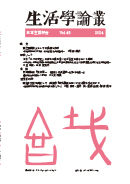最新号
選択された号の論文の5件中1~5を表示しています
- |<
- <
- 1
- >
- >|
論文
-
2024 年 45 巻 p. 1-14
発行日: 2024/09/30
公開日: 2024/12/26
PDF形式でダウンロード (1545K)
研究ノート
-
2024 年 45 巻 p. 15-29
発行日: 2024/09/30
公開日: 2024/12/26
PDF形式でダウンロード (543K)
書評
-
2024 年 45 巻 p. 30-35
発行日: 2024/09/30
公開日: 2024/12/26
PDF形式でダウンロード (310K)
受賞者の声
-
2024 年 45 巻 p. 36
発行日: 2024/09/30
公開日: 2024/12/26
PDF形式でダウンロード (147K)
学会記録
-
2024 年 45 巻 p. 37-40
発行日: 2024/09/30
公開日: 2024/12/26
PDF形式でダウンロード (215K)
- |<
- <
- 1
- >
- >|
